Heanor Breach Road Flood Alleviation Scheme (2017)
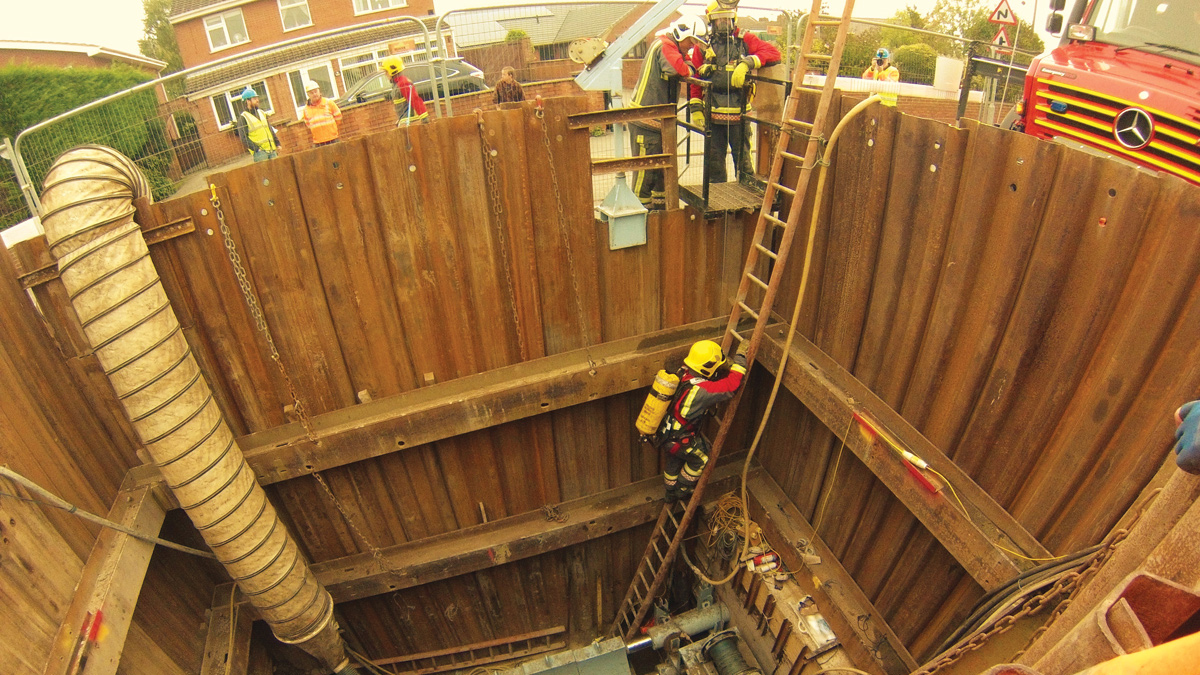
Fire and Rescue emergency preparedness practice simulations - Courtesy of NMCNomenca
Severn Trent Water has completed the £1m Heanor Breach Road Flood Alleviation Scheme which will reduce the flooding witnessed by numerous properties on Breach Road, Heanor. The scheme works by quickly conveying the combined sewer water away from the properties at risk of flooding and safely storing it in a 163m long 2.1m diameter tunnel. The solution is designed to limit the pass forward flows from the tunnel at 180l/s through a 30m throttle pipe which ensures the properties downstream remain safe from the flood waters. The complex hydraulic design of the scheme ensures minimal future maintenance and operates entirely without a single moving part.
Design complexity
The complexity of the flooding issues associated with the steeply sloping urban catchment area around Breach Road and its residential surroundings was investigated following secured funding from Severn Trent Water. Under the AMP6 framework agreement NMCNomenca (now Galliford Try) was appointed as design and build contractor and worked closely with the STW solution team to develop the best TOTEX solution for the £1m scheme.
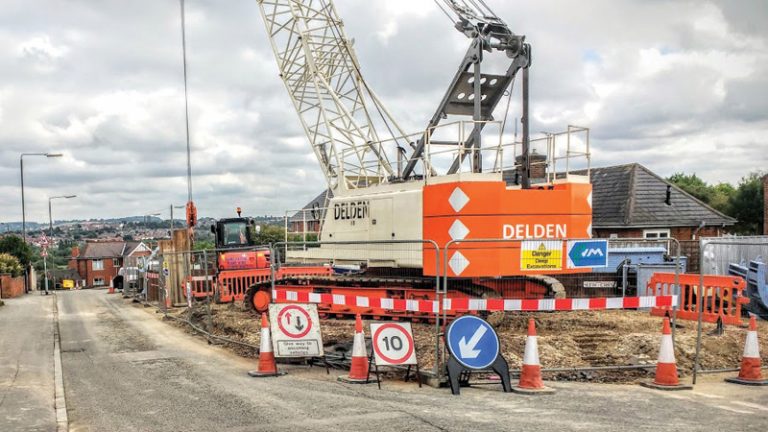
Site constraints during construction – Courtesy of NMCNomenca
During initial feasibility stages of the design, it became apparent that providing the required 573m3 of storage in the middle of housing estate was no simple task. Boreholes revealed Pennine Middle Coal Measures formations, which presented a mixture of hard sandstone and mudstone at less than 2m depth. Further design challenges were encountered following detailed site investigation which revealed extensive high voltage cables, major fibre optic ducts and numerous abandoned cast iron gas and water services.
Tunnel vision
In order to achieve such a large storage volume and to avoid the disruption and potential service diversions associated with traditional open cut techniques, the design team was forced to think deep. By innovatively using the existing steep local topography, the tunnel could be safely constructed 6m deep whilst ensuring the waters returned back to the existing sewer network under gravity. This technically difficult gravity approach results in minimal operating costs for STW. The tunnel is designed at a 1 in 79 gradient which ensures self-cleansing velocities are achieved daily, thus reducing future maintenance costs or risks associated with lowering operatives into the tunnel.
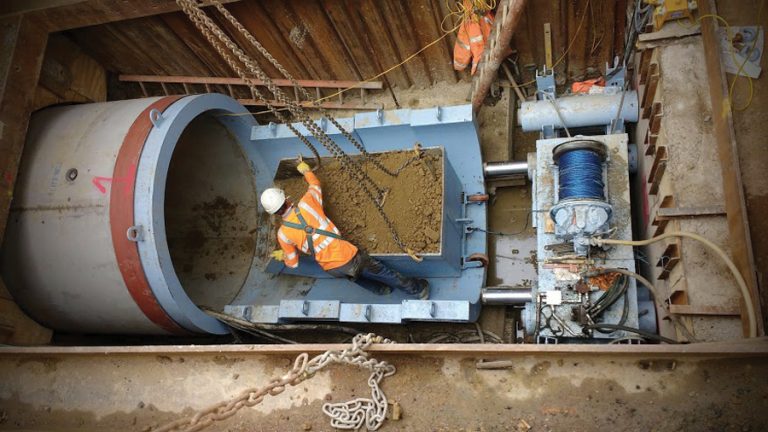
Drive pit during tunnelling operations – Courtesy of NMCNomenca
Innovation at its heart
Tunnelling operations were carried out by specialist sub-contractor F&B Trenchless, who installed the tunnel using an open faced back actor tunnel boring machine (TBM). Each 2.1m diameter pipe was lowered into the drive pit and using pipe jacking techniques, 4 (No.) large hydraulic rams pushed the tunnel until the full 163m length was achieved. To reduce the overall compressive stresses on each pipe, an interjack setup was commissioned within the tunnel instead of an intermediate drive pit which helped reduce the disruption to local residents.
NMCNomenca’s drive to encourage off site manufacturing led to some of the largest Polypipe prefabricated manholes to have ever been specified. The 6m deep chambers fully fitted with pull up stainless steel ladders, bespoke benching, backdrops and inspection chambers were manufactured specifically to tie onto the jacking pipes used in the tunnel. These pioneering drive and reception pit chambers were installed in one working day which saved on programme, cost and disruption to local residents.
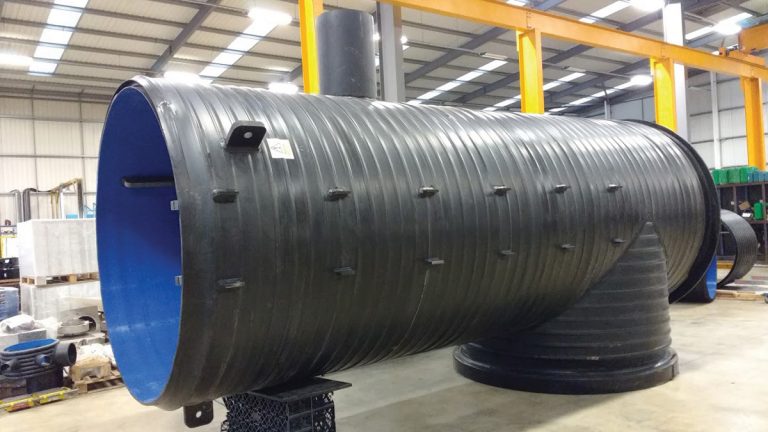
Polypipe fabricated chamber – Courtesy of NMCNomenca
Light at the end
Sustainability remained a key driver throughout the design process, with the entire team striving towards minimizing the overall environmental impact of the project. The tunnelling solution vastly reduced the initial predicted environmental impact of the scheme as the quantity of excavated material required to be transported off site was limited to the small over-dig from the tunnelling operations compared to the vast volumes predicted in a traditional open cut solution.
Highway reinstatement was limited to the tunnel drive and reception pits, leaving any contaminated tarmac coal tars undisturbed up the existing carriageway. The major environmental saving is designing away from any mechanical and electrical equipment which ensures no running costs, and very low future maintenance. An emergency high level overflow incorporated in the tunnel safeguards nearby properties from any storm events greater than 1 in 40 years or if the 225mm diameter throttle pipe were to block and inadvertently cause the tunnel to fill.
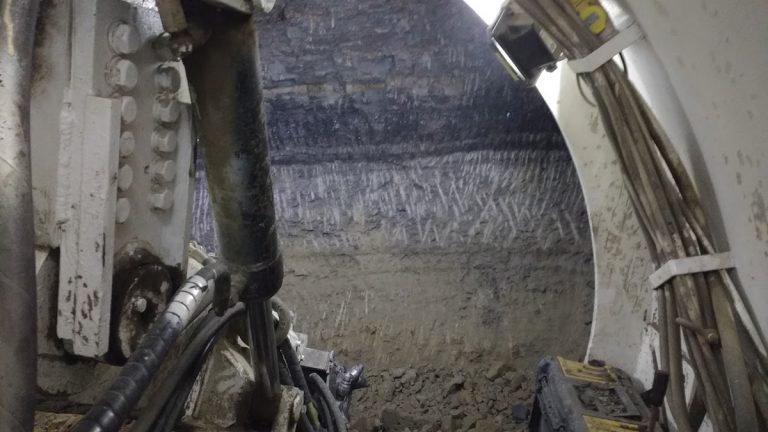
Exposed rock formation at TBM face – Courtesy of NMCNomenca
Communications
It was identified at an early stage that the general public living near Breach Road was going to be subject to significant disruptions from the road closures and construction related activities taking place, so a comprehensive stakeholder management plan was put into place. The team delivered a staggering 2,270 letters throughout the design and build process informing the residents of the upcoming works and of progress on site.
A very well attended public consultation event took place in June 2016 in a nearby church as an opportunity to explain first-hand the proposals and answer the many queries from the curious residents. Concerns were raised by individuals over the chosen access location for the nearby site compound, and after subsequent amicable meetings on site this moved slightly further away from some existing dwellings. Following the works, NMCNomenca reinstated the private road which accessed the site compound with a new tarmac finish as a gesture of goodwill.
NMCNomenca also visited the local primary school where assembly presentations were made highlighting the dangers of construction sites to school children. The opportunity was also taken to explain where the flood alleviation works fit within the natural water cycle and to promote STW’s social responsibility message of what’s safe to be flushed into the sewerage system.
Safety
Due to the complexities and bespoke designs associated with this scheme, some of the standardised safe design guidance documents were reviewed to reduce the holistic overall risk of construction and future usage. Manhole lids over the tunnel were specified with larger openings to aid forced air ventilation, secondary fall prevention gridding was fitted to all manholes above 3m in depth and pull up ladders fitted to aid with access and egress.
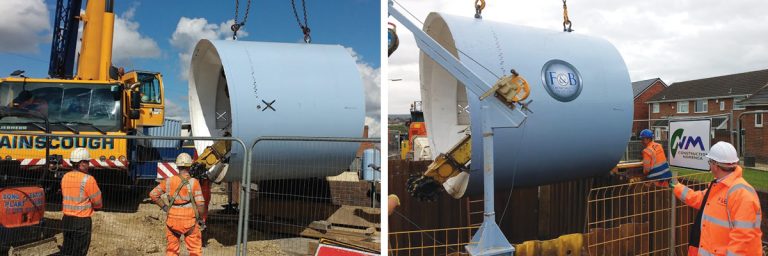
TBM launch – Courtesy of NMCNomenca
The narrowing of a 2.1m diameter tunnel to a 225mm diameter throttle pipe was identified as a potential future blockage risk and the benching detail was elongated by an extra meter to allow easy inspection and clearance of any blockages. The tunnel centreline was purposely designed offset to the centre of the carriageway to allow future access or inspection via single lane closures instead of a lengthy road closure notice. Single lane closures also allowed continuous tunnelling operations whilst open cut works took place upstream. Allowing these to run together resulted in a much shorter construction programme and less disruption to the local residents.
All construction activities took place without a single lost time incident and the site team successfully passed all Health & Safety and Environmental audits. NMCNomenca worked closely with the piling supplier under an initiative to reduce the amount of working at height and helped trialling and developing a self-releasing pile driving prototype which is now being rolled out as a standard product through Groundforce Shorco.
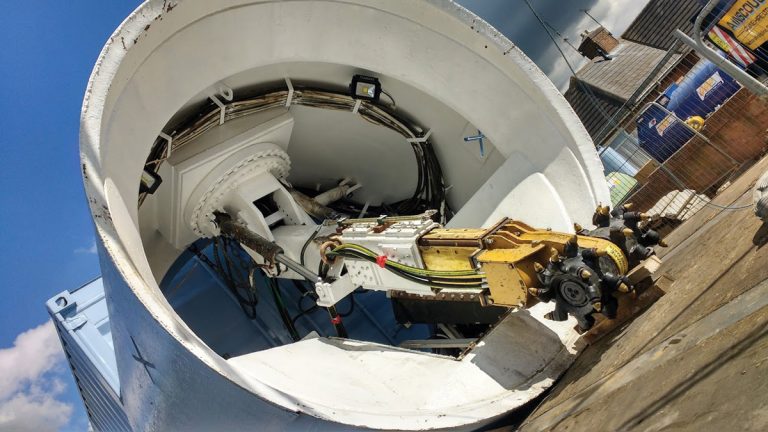
Rock wheel attachment during TBM assembly – Courtesy of NMCNomenca
Lasting legacy
The Breach Road Flood Alleviation scheme’s legacy was further cemented by a collaborative approach to solving the wider flooding issues in the area. Derbyshire County Council acknowledged the lack of capacity in the existing highway network drainage to deal with overland flows during periods of heavy downpours and funding was agreed to incorporate the addition of 13 new highway gullies into the scope of the project.
This is in line with STW’s wider work for driving partnership with other risk management authorities to solve holistic flooding issues.
Throughout the duration of the project, Collaborative Planning was implemented in order to apply product control methods to realise efficiencies in the project programme. This allowed STW, NMCNomenca and the whole supply chain to collaborate over timescales associated with each individual’s requirements.
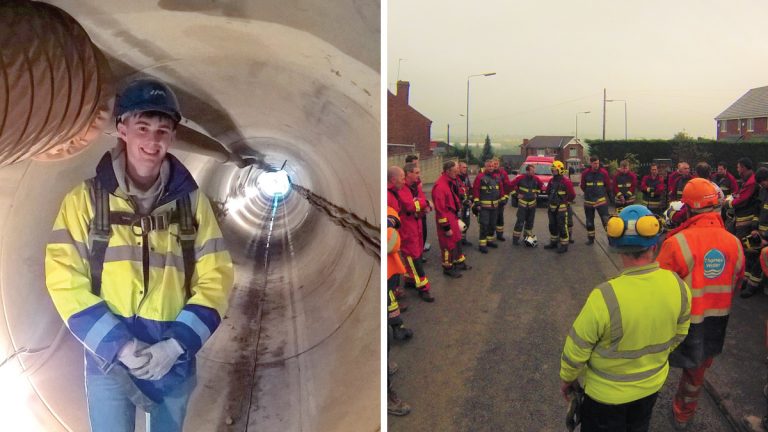
(left) Tunnel during construction and (right) – team debrief and review of emergency arrangements post practice exercise – Courtesy of NMCNomenca
Enthusiasm within the team to further promote the excellent H&S record of the scheme led to the invitation for the nearby Derbyshire Fire and Rescue units to use the tunnel as a real life high risk confined space training exercise.
Many of the local residents were invited to witness the training exercise which was followed by a mutually beneficial debrief between NMCNomenca and the Mines Rescue team over the effectiveness of the emergency preparedness plans.
Derbyshire Fire and Rescue Service Group Manager Bob Curry explained:
“By taking part in exercises which simulate real situations, our firefighters can train to deal with all manner of incidents, as well as develop closer working practices with partners and other emergency services – this is why working with partners such as Severn Trent and NMCNomenca on exercises such as this is invaluable”.





